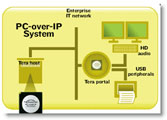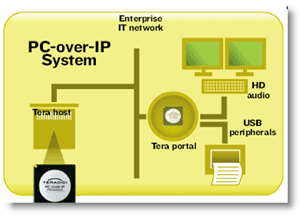« Microsoft preps StartKey -- Windows on a Stick | Main | Licensing Windows in Multiuser Scenarios »
March 04, 2008
PC over IP Buzz
 PC over IP: The next wave in thin clients IBM, ClearCube employ Teradici chipset to transmit data, graphics over IP network PC over IP: The next wave in thin clients IBM, ClearCube employ Teradici chipset to transmit data, graphics over IP network |
An emerging approach to thin computing goes beyond the delivery of applications to clients, instead delivering — in effect — the PC.
Called PC over IP, the technology uses chipsets that compress the entire PC experience at the data center and transmit it over a TCP/IP network to thin-client devices, where it is decompressed and made ready for use.
The benefits are ease of management and better security because no applications reside on the users’ clients, experts say.
IBM and ClearCube Technologies — both well-established in the government sector — have jumped on the bandwagon, incorporating the chipset from Teradici in their blade server technologies. Experts see a role for the technology in defense, intelligence and civilian agencies.
“Instead of accessing the Internet with the PC, the phenomenon of PC over IP means your entire PC workloads — your spreadsheets, your word processors — are being hosted remotely. Then you can have a thin device that is low-power and lightweight to do the work” at the user’s site, said Tom Bradicich, a fellow and vice president of Rack/Blade/x86 servers at IBM.

Hardware approach
“Teradici stands unique in that it is a hardware approach to moving the graphics and video over the network,” he said.
Bradicich said a blade system with the Teradici chipsets could appeal to government agencies because data and applications are protected at the data center rather than residing on desktop or mobile devices.
Also, communications over the Internet or the local-area network between the data center and thin client are encrypted with the 128-bit Advanced Encryption Standard, and the management and USB communications, such as keystrokes, are protected by Secure Sockets Layer security.
The IBM BladeCenter HC10 solution with the Teradici chipset was introduced in September. Bradicich said some government users are evaluating it.
“What’s cool about the Teradici technology is that, for the first time, power users can take advantage of this full-performance desktop capability unhindered by distance,” said Susanna Kirksey, vice president of marketing at ClearCube.
Many user port devices link to the data center via Category 5 telephone cable, which has a 200-meter distance limitation, she said. With PC over IP, all desktop functionality can be transmitted over a TCP/IP network, so mission- critical environments do not have distance limitations from the data center to the desktop, she said.
ClearCube introduced products in June that incorporate the Teradici chipset. The company unveiled three user port devices — the I9420, I9440 and C7420 — that provide dual- and quad-monitor, full-performance graphics via an IP connection.
The Teradici chipset consists of a host and a portal processor. The Tera 1200 host processor resides in blade workstations or PCs in a data center and supports dual Digital Video Interface displays at 1,920 x 1,200 resolution. It also provides USB and high-definition audio bridging, USB device authorization and encrypted communications.
The hardware bridging eliminates the need for drivers, Teradici officials said.
Desktop device
The Tera Portal Processor is integrated at the user’s desk into a Desktop Portal, a small device shaped like a hockey puck. Input comes from the enterprise network via a standard Ethernet connector. Output is driven by one or two DVI ports for display and USB and audio ports for peripherals.
Teradici’s hardware solution has advantages over software-based products, said Mike DeNeffe, vice president of marketing and business development at Teradici.
“In our approach, we have a chip on either end, so we offloaded the heavy lifting that goes into the compression and decompression, particularly on the CPU,” DeNeffe said.
However, blade technology that uses software to achieve the same result could offer more flexibility, said Pat Duba, remote workstations solutions manager for blade workstations at Hewlett-Packard.
A software approach lets HP offer a broader portfolio of computing approaches, Duba said, whether a user needs a dedicated PC, workstation or shared virtualization infrastructure.
HP’s PC Blades provides users with fully functional, personalized desktops delivered via a connection from PC blades in a centralized data center. HP’s Remote Graphics Software provides enhanced video and graphics performance for high-end workstation and PC users over standard protocols, such as Microsoft Remote Desktop Protocol.
The task for an agency considering PC over IP is to determine whether a hardware- or software- based approach is best for their environment, experts say
Posted by staff at March 4, 2008 03:00 PM